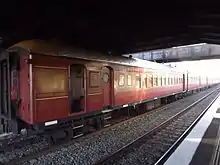New South Wales N type carriage stock
The N type carriage stock was a type of steel passenger carriage operated by the Department of Railways New South Wales and its successors from 1939 until the late 1980s.

History
In September 1938 the Department of Railways New South Wales awarded a contract to Waddington, Granville for 35 steel carriages.[1][2] They were equipped with forced air ventilation and downward opening windows. Neither were successful and were replaced by more conventional fittings.[3]
The cars were delivered as 5 NUB sets of seven cars, normally marshalled as HFN, FN, FN, BN, BN, FN and HFN. Car numbers were initially 2177-2211 and the cars being numbered sequentially within each set. Cars 2200-2211 were subsequently renumbered to 1738-1748 to accommodate XPT car numbering. The BN cars were first class cars and sat 56 passengers in seven semi-partitioned sections. The FN cars were second class cars and could seat 78 passengers. The HFN cars were second class brake vans and could seat 68 passengers.[1]
In May 1944 they were placed on the Newcastle Flyer services until replaced by HUB sets from 1948.[4] They were also used on the Cessnock Express.[2]
By 1969 five cars were modified from FN to RFN to provide additional buffets for the NSWGR fleet. The modified cars were three long tons (3.36 short tons; 3.05 t) lighter and had a capacity of 47 passengers.[5] A number were modified to BAM sleepers for use on longer distance trains which allowed retirement of a number of the older TAM type sleepers.
Over the years they operated on both express passenger and mail train services. In May 1968 some were converted for use on the Brisbane via Wallangarra service while in June 1970 others were modified for use on the Southern Highlands Express.[3][6][7] They were withdrawn in the late 1980s following the cessation of the Northern and Western Mails.
Fleet Status
| NUB Delivery Set | Original Code | HFN | FN | FN | BN | BN | FN | HFN |
|---|---|---|---|---|---|---|---|---|
| 110 | Original Number | 2177 | 2178 | 2179 | 2180 | 2181 | 2182 | 2183 |
| Current/last code/number | RFN | SFN | ||||||
| Owner/Custodian | ECHR | |||||||
| Location | Captains Flat | Port Kembla | ||||||
| Condition | Shell Only | Scrapped | Scrapped | Scrapped | Operational | |||
| 111 | Original Number | 2184 | 2185 | 2186 | 2187 | 2188 | 2189 | 2190 |
| Current/last code/number | FNR | FRN | RFN | SCN | BAM | |||
| Owner/Custodian | THNSW | ECHR | THNSW | Chumrail | ||||
| Location | Eveleigh | Port Kembla | Thirlmere | Rothbury | ||||
| Condition | Restoration | Operational | Scrapped | Operational | Shell only | |||
| 112 | Original Number | 2191 | 2192 | 2193 | 2194 | 2195 | 2196 | 2197 |
| Current/last code/number | ABN | SBN | HN | |||||
| Owner/Custodian | DSRM | NSW Govt | ECHR | ECHR | GMR | THNSW | ||
| Location | Dorrigo | Eveleigh | Port Kembla | Port Kembla | Glenreagh | Thirlmere | ||
| Condition | Shell only | Operational | Operational | Operational | ||||
| 113 | Original Number | 2198 | 2199 | 2200 | 2201 | 2202 | 2203 | 2204 |
| Current/last code/number | HN | FNR | BHM 1738 | RFN 1739 | SCN 1740 | BAM 1741 | 1742 | |
| Owner/Custodian | CRM | SSR | CRM | CRM | ||||
| Location | Canberra | Canberra | Canberra | Rothbury | ||||
| Condition | Operational | Operational | Operational | Operational | Scrapped | |||
| 114 | Original Number | 2205 | 2206 | 2207 | 2208 | 2209 | 2210 | 2211 |
| Current/last code/number | BAM 1743 | BAM 1745 | CN 1747 | BAM 1748 | ||||
| Owner/Custodian | DSRM | THNSW | CFCLA | |||||
| Location | Rothbury | Lake Burrendong | Dorrigo | Thirlmere | Goulburn | |||
| Condition | Shell only | Operational | Scrapped | Operational |
References
- Cooke, David (2003). Coaching Stock of the New South Wales Railways. Eveleigh Press. ISBN 1-876568-01-1.
- Dunn, John (2006). Comeng: A History of Commonwealth Engineering Volume 1: 1921-1955. Kenthurst: Rosenberg Publishing. pp. 55–57. ISBN 1877058424.
- "Carriage Review" Railway Digest December 1986 page 393
- The Flyer. Sydney: New South Wales Rail Transport Museum. 1970. ISBN 0-909862-16-8.
- 1969 General Appendix, Department of Railways, New South Wales, page 445
- "20 Years Ago" Railway Digest May 1988 page 190
- "20 Years Ago" Railway Digest June 1990 page 230